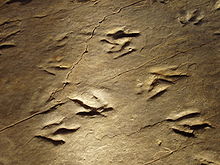19th century in ichnology
British paleontologist William Buckland performed the first true scientific research on the subject during the early 1830s.
After acquiring the specimen, Buckland experimented with modern animals to ascertain the trackmaker and concluded that the Scottish footprints were made by tortoises.
[1] Later in the century famed advocate of evolution Thomas Henry Huxley would refute this attribution and these footprints, called Chelichnus, would remain without an identified trackmaker until scientists recognized that they were actually made by an evolutionary precursor to mammals.
The identification of the Chirotherium trackmaker proved elusive and suggestions from researchers included everything from monkeys to giant toads and kangaroos.
[6] Late in the 19th century prisoners in Nevada discovered a major Ice Age track site at what was once an ancient lake shore.








